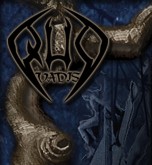Hi everyone, at a
recent show someone walked up to me and asked me a few
questions about the beginning to "Mute Requiem"
from Day Into Night. Since the writing phase for the new
album is finished I had the time to write down the
beginning of the song last week and decided to use
this opportunity to refresh the lessons section of the
site. If you have any questions about Quo Vadis songs
feel free to contact me, and, time permitting, I'd be happy to help you out.
Let me begin by
focusing on the two main riffs comprising the intro to
the song - let's call them RIFF ONE and RIFF
TWO.
In the case of
both riffs we have the second guitar joining in for
rhythmic and harmonic reinforcement. The key
signatures are pretty standard for Quo Vadis songs. RIFF
ONE is in E Harmonic Minor (Em with a raised 7th
note). For RIFF TWO we have the
more solid sounding E Minor Natural. In the context of
the song the switch from one scale to the next helps
resolve the tension created by RIFF ONE.
For more
information on the basics of the Harmonic Minor scale
and some notes on relative major and minor scales,
please refer to lesson 1
and lesson2.
The harmonic minor
scale is often used in metal for its slightly exotic
feel, here are some reasons why:
In the case of the
E Harmonic Minor scale, the raised note [the 7th
note of the E-minor scale] is a D sharp (D#). This is
the specific note that gives RIFF ONE its tense
and mysterious feel. The raised 7th is only
one semitone away from the tonic of the scale [D# to
E], and it is this interval that creates the mood of
the scale.

